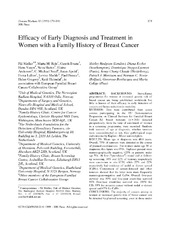| dc.contributor.author | Møller, Per | |
| dc.contributor.author | Reis, MM | |
| dc.contributor.author | Evans, G | |
| dc.contributor.author | Vasen, H | |
| dc.contributor.author | Haites, N | |
| dc.contributor.author | Anderson, E | |
| dc.contributor.author | Steel, CM | |
| dc.contributor.author | Apold, Jaran | |
| dc.contributor.author | Lallo, F | |
| dc.contributor.author | Mæhle, L | |
| dc.contributor.author | Preece, P | |
| dc.contributor.author | et al., - | |
| dc.date.accessioned | 2016-06-09T07:31:22Z | |
| dc.date.available | 2016-06-09T07:31:22Z | |
| dc.date.issued | 1999 | |
| dc.Published | Disease Markers 1999, 15:179-186 | eng |
| dc.identifier.issn | 0278-0240 | en_US |
| dc.identifier.uri | https://hdl.handle.net/1956/12083 | |
| dc.description.abstract | BACKGROUND: Surveillance programmes for women at increased genetic risk of breast cancer are being established worldwide but little is known of their efficacy in early detection of cancers and hence reduction in mortality. METHODS: Data were contributed from seven centres participating in the EU Demonstration Programme on Clinical Services for Familial Breast Cancer. All breast tumours (n = 161) detected prospectively, from the time of enrolment of women in a screening programme, were recorded. Analysis took account of age at diagnosis, whether tumours were screen-detected or not, their pathological stage and outcome by Kaplan—Meier survival plots. RESULTS: Mean age at diagnosis was 48.6 years. Overall, 75% of tumours were detected in the course of planned examinations. For women under age 50 at diagnosis, this figure was 68%. Eighteen percent were mammographically negative, (23% in patients under age 50). At first (“prevalence”) round and at follow-up screening, 16% and 22% of tumours respectively were carcinoma in situ (CIS) while 27% and 22% respectively had evidence of nodal or distant spread (CaN+). Comparison of screen-detected and other tumours showed that the latter were more frequently mammogram-negative and CaN+. Overall five-year survival was 89% and five-year event-free survival 86%. Five-year event-free survival was 100% for CIS, 88% for invasive cancer without nodal or distant spread and 67% for CaN+. CONCLUSIONS: The majority of cancers arising in women at increased genetic risk of breast cancer can be detected by planned screening, even in those under age 50. Surveillance should include regular expert clinical examination and teaching of “breast awareness” as well as mammography. Attention to the logistics of screening programmes may improve still further the proportion of tumours that are screen-detected. The trend towards earlier pathological stage in tumours detected during follow-up rounds and the preliminary findings on survival analysis suggest that this approach will prove to be of long-term benefit for breast cancer families. | en_US |
| dc.language.iso | eng | eng |
| dc.publisher | Hindawi Publishing Corporation | en_US |
| dc.rights | Attribution CC BY 3.0 | eng |
| dc.rights.uri | http://creativecommons.org/licenses/by/3.0/ | eng |
| dc.subject | inherited | eng |
| dc.subject | familial | eng |
| dc.subject | breast cancer | eng |
| dc.subject | prognosis | eng |
| dc.subject | stage | eng |
| dc.subject | diagnosis | eng |
| dc.subject | survival | eng |
| dc.subject | screening | eng |
| dc.subject | mammography | eng |
| dc.title | Efficacy of early diagnosis and treatment in women with a family history of breast cancer | en_US |
| dc.type | Peer reviewed | |
| dc.type | Journal article | |
| dc.date.updated | 2016-04-07T08:45:17Z | |
| dc.description.version | publishedVersion | en_US |
| dc.rights.holder | Copyright 1999 Hindawi Publishing Corporation | en_US |
| dc.identifier.doi | https://doi.org/10.1155/1999/805420 | |
| dc.identifier.cristin | 390692 | |
| dc.subject.nsi | VDP::Medisinske Fag: 700 | en_US |

